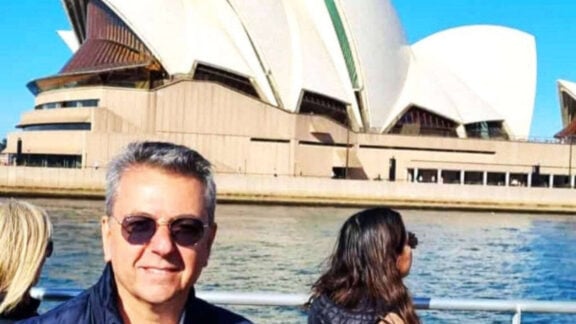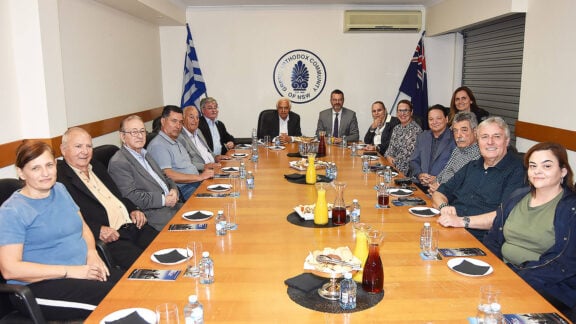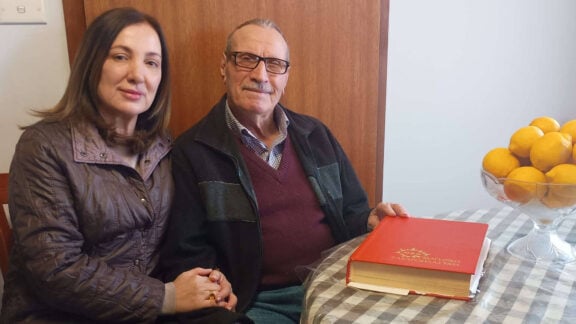On Monday 3 October, the last Anzac nurse of Hellas, Mrs Una Keast, passed away. She was the last of the Australian nurses who served in Athens and on Crete in April and May 1941.
In April this year, a delegation of the Grand Lodge of NSW and NZ together with Consul General Dr Stavros Kyrimis, visited Mrs. Keast. On behalf of AHEPA NSW, Grand President Bro. John Kallimanis presented her with a bronze statue of Anzac hero John Simpson Kirkpatrick with his donkey from Lemnos, accompanied by a certificate of appreciation for Mrs Keast’s service to liberty and democracy.
Memories
Una Clara Keast (nee Mills), was born in Tottenham NSW, 500km west of Sydney, in 1915. She attended school at PLC Orange and went on to study nursing in Sydney. In 1940, she joined her three elder siblings in enlisting in the Australian Army.
In April 1941, by then Captain Una Mills was transferred – as part of the 2/5 Australian General Hospital.
“We were at a place called Ekali which was a summer resort for the wealthy from Athens. It was very beautiful, up there. We took over a hotel and some of us lived in an old barn. We weren’t there for long and we were busy getting wards ready to be occupied which so many of them were “… and the Germans flew so low you could see the colour of their eyes!”

With the withdrawal of the Allied forces, she was relocated. “We travelled by armoured vehicles at night. In the morning, we disembarked into a Greek cemetery. We managed to find a well in and we used our tin hats to lower them in and bring up some water so that we could wash our face and hands. We were strafed by the Germans while we were there and again later, during the embarkation close to the Corinth Canal.
From the shore of Nafplion,160 nurses – amongst them Captain Mills – were evacuated to Souda Bay on Crete. With difficulty,Mrs Keast held back her tears as she described the moment when she learned of the death of the Commander of the 2/5 Australian General Hospital, at Piraeus on 26 April 1941. Colonel W. E. Kay DSO died of wounds received from German fire when he was endeavouring to organise the evacuation of 400 wounded and ill at the Hospital, together with approximately 500 British civilians, aboard the vessel Hellas. Alongside him were killed up to 742 people.
Aboard the Australian warship HMAS Voyager, they escaped Central Greece for Crete. Provoking laughter amongst those present, Mrs Keast related her arrival aboard ship: “We had to climb the ropes until we reached the deck of the ship. As I approached the deck, a sailor said: ‘Give me your hand mate.’ I replied: ‘Oh, I’m quite alright, thank you.’
‘They were really taken aback! ‘Strewth! Be women!’ They were marvelous boys. They rescued us and talked and talked and talked all night, they were just so happy to find someone speaking the same language: Australians to talk to Australian women. It was wonderful!”
During the quiet event in April, Consul-General Dr Stavros Kyrimis stated: “I thank and congratulate AHEPA NSW for the praise worthy effort with the series of events around the Anzacs of Hellas in 1941. Mrs. Keast, despite the weight of years, quite deservedly is honoured today for her services to her fellow human beings.”
Grand President Bro. John Kallimanis had declared: “Just as with February’s event for Mr. Alf Carpenter, in the heroic figure of Mrs. Keast, AHEPA NSW honours all the nurses of the Allied forces who risked their lives to save others. This constitutes our obligation. As Hellenes and as Australians.”
Grand Secretary Dr Panayiotis Diamadis:“75 years ago, Mrs Keast, together with her comrades, fulfilled their duties to their country. We now fulfill our obligations, so that the flame of memory of the Anzac’s achievements in Hellas never fades ”.
The Grand Lodge, the members and friends of AHEPA NSW expressed their sincerest condolences to the family of Mrs Keast.
Eternal be her memory.









